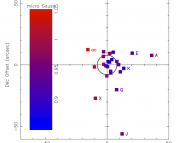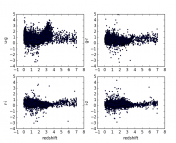In July we put out a call for descriptions of research being done by undergraduates, and we got a great response! You can read the first post of this series here; today we’re publishing the second installment.
Again, you can share what you’re doing too by emailing brief (fewer than 200 words) write-ups of your work to [email protected]. The target audience is one familiar with astrophysics but not necessarily your specific subfield, so write clearly and try to avoid jargon. Feel free to also include either a visual regarding your research or else a photo of yourself!
We look forward to hearing from you!
| Ye Quanzhi Sun Yat-sen University, China Despite the fact that my undergraduate major was not astronomy, I have done a few works in this field during my undergraduate time, mainly driven by interest. Two of the works were eventually posted in refereed journals, and I was since admitted by an astronomy graduate program and will be starting this fall.
One of these projects was initiated during my high school time, while I was very interested in asteroid searching and got some experience from survey databases such as the Near-Earth Asteroid Tracking program. I was fortunate enough to find the National Central University’s Lulin Observatory, which happened to have a small robotic telescope in spare and agreed to let me coordinate the program. The program (namely the Lulin Sky Survey, or LUSS) was very successful, discovering hundreds of asteroids plus a naked-eye comet, and I became familiar with various topics such as orbital dynamics as well as programming. The results of the LUSS program were later presented as a poster in the ’09 AAS/DPS meeting. I met some professionals at the meeting and was encouraged to investigate asteroid photometry. I then focused my eyes on near-Earth objects (NEOs) and applied for time on the Lulin 1m telescope. By surveying some small NEOs, combining the results from predecessors and analyzing the results, I was able to conclude the smaller NEOs tend to have different color than larger NEOs, which was opposed to some earlier model predictions. This result was published in the Astronomical Journal. It is important to note that despite the fact that I have no supervisor guiding me on the work, the professionals I met during the operation of the LUSS program and the DPS meeting gave me many valuable suggestions that helped me to refine the manuscript. I hope my experience will be useful for undergrads who are (currently) far from an astronomy major but have an intense interest in doing astronomy.
|
| Justin Vasel University of Wisconsin-Eau Claire My work for the past few years has been investigating X-ray production in hot stars. It is well known that large, hot stars are good at making X-rays that we can measure with telescopes. That turns out to be very confusing, however. Based on what we understand about the internal structure of these hot stars, they should not be emitting any X-rays.To explore this unsettling phenomenon, I have been examining computer models that simulate the atmospheres of hot stars. When provided with a surface temperature and star size, the computer models generate a simulated spectrum for that star. Using those spectra, I have been analyzing what are called FIR (far infrared) lines. The ratio of some of these spectral lines can be used to determine how far away from the surface of the star these X-rays are being produced. Hopefully, understanding more about where the X-rays are produced will help us to uncover the mechanisms that drive X-ray production. My research is far from conclusive at the moment, but signs point to fast stellar ‘winds’ as the culprit.
|
Many thanks to Quanzhi and Justin for their contributions!




Trackbacks/Pingbacks